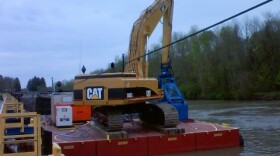The Hudson River cleanup isn’t done yet. That’s according to the New York state Department of Environmental Conservation, which released a study Thursday showing General Electric's cleanup of PCB contamination in the upper Hudson River is incomplete. It’s the latest effort to convince the U.S. Environmental Protection Agency to refrain from issuing GE a certificate of completion. GE disagrees.
New York Governor Andrew Cuomo released the DEC study, indicating General Electric’s PCB cleanup along a 40-mile stretch of the upper Hudson River is not protective of public health and the environment. Outgoing DEC Commissioner Basil Seggos is urging EPA not to deem the project complete.
“This job’s not done and there’s more contamination than we all would have expected when we embarked upon this many years ago,” Seggos says.
Seggos says it was important to release the data to the public and impress upon EPA that more cleanup is needed. Other stakeholders have recently said they believe EPA is on the brink of a decision. Seggos says DEC has been in heavy dialogue with EPA officials all year.
“We’ve had some high-level conversations with our technical staff and legal staff and that, as recently as early December, when we had a final discussion about the data, and they indicated they were in their last stages, and I have no doubt they’re angling towards making a decision in the next two weeks,” says Seggos.
GE removed 2.65 million cubic yards of contaminated sediment through 2015. The EPA, in its second review of the cleanup of PCBs from the upper Hudson River, said that the $1.7 billion, six-year cleanup of the Superfund site is working, and will accomplish its long-term goal of protecting human health and the environment. An EPA spokeswoman says the agency has not yet made a decision regarding GE’s request for Certification of Completion of the Remedial Action or the Five-Year Review, and expects to finalize its decisions on these matters in early 2019. Mark Behan is GE spokesman.
“New York state knows full well that it agreed to and concurred in the standards that EPA set for this project. It embraced and endorsed the remedy. It was thoroughly supportive of the dredging project. They had oversaw the dredging project with EPA. And it was instrumental in every single decision about the dredging project,” Behan says. “And its own data, the state’s own data, show, that 99.8 percent of the sediment samples they took meet the criteria that EPA set. The state also knows that GE met or exceeded all of its obligations on the Hudson River.”
DEC collected hundreds of sediment samples in summer of 2017, confirming that elevated levels of PCBs remain in the surface sediment of the Hudson River. Seggos says DEC sampled nearly 1,700 locations and its data showed that, in many areas, the average PCB concentrations exceed the 1 part per million cleanup level typically used by DEC for sediment cleanup projects.
“What we also have looked at is the fish concentrations, the PCB levels in fish concentrations,” Seggos says. “So we went out and conducted about 230 different fish samples and determined that the average PCB levels in fish in the Hudson River have effectively remained unchanged so, the same levels prior to cleanup, which, to us, shows that there are some lingering and very significant concerns in the river.”
GE’s Behan shines a different light on the state data.
“In fact, what we know from the state’s work and others is that PCB levels have dropped as much as 96 percent in the sediment in the upper Hudson. PCB levels in water have dropped at every monitoring station along the Hudson and PCBs in the larger fish that people eat have also declined very significantly,” Behan says. “Dredging clearly is working, and the data demonstrate that.”
The spokeswoman says EPA was expected to make a decision on the Certification of Completion in January 2018, but put the decision on hold to work through and understand sediment and fish data with DEC. She adds that the EPA decision will come after considering the results of what she describes as exhaustive consultation and collaboration with New York’s DEC. Should the EPA issue a certificate of completion, Seggos says the state stands ready to take action.
“If that means litigation, if it means taking a strong legal path to forcing the federal government into making the right decision, we’re prepared to take that,” says Seggos. “But ultimately, we want science to be our guide here. We want science to convince the federal government to make the right determination. And if they do so, we’ll be there right with them; if they’re not, then we’ll be in court.”
DEC is also calling on EPA to direct GE to collect additional data to determine if another round of sediment remediation is needed. In addition, DEC says that EPA must compel GE to fund a full investigation of the lower Hudson, where PCB concentrations in fish have not recovered and, if GE refuses, EPA should fund this work. The spokeswoman says that regardless of EPA’s upcoming decisions, GE remains legally responsible for its PCBs that reached the Lower Hudson River, from Troy south to New York City harbor. EPA has begun an assessment of the Lower Hudson to determine whether a more detailed study and additional cleanup is necessary in this portion of the river.
Hudson Valley Congressman Sean Patrick Maloney and five of his Democratic House colleagues signed a letter December 19 to the acting EPA administrator, calling for the agency to withhold its final Certificate of Completion to GE. And at the beginning of the month, Poughkeepsie-based Scenic Hudson released a study it commissioned based on the DEC data showing that PCBs have re-contaminated dredged areas of the upper Hudson River. In November, Republican Dutchess County Executive Marc Molinaro wrote to EPA Regional Administrator Pete Lopez, asking EPA to refrain from issuing a Certificate of Completion.







